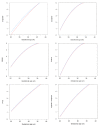Effect of malaria in pregnancy on foetal cortical brain development: a longitudinal observational study
- PMID: 22747687
- PMCID: PMC3483189
- DOI: 10.1186/1475-2875-11-222
Effect of malaria in pregnancy on foetal cortical brain development: a longitudinal observational study
Abstract
Background: Malaria in pregnancy has a negative impact on foetal growth, but it is not known whether this also affects the foetal nervous system. The aim of this study was to examine the effects of malaria on foetal cortex development by three-dimensional ultrasound.
Methods: Brain images were acquired using a portable ultrasound machine and a 3D ultrasound transducer. All recordings were analysed, blinded to clinical data, using the 4D view software package. The foetal supra-tentorial brain volume was determined and cortical development was qualitatively followed by scoring the appearance and development of six sulci. Multilevel analysis was used to study brain volume and cortical development in individual foetuses.
Results: Cortical grading was possible in 161 out of 223 (72%) serial foetal brain images in pregnant women living in a malaria endemic area. There was no difference between foetal cortical development or brain volumes at any time in pregnancy between women with immediately treated malaria infections and non-infected pregnancies.
Conclusion: The percentage of images that could be graded was similar to other neuro-sonographic studies. Maternal malaria does not have a gross effect on foetal brain development, at least in this population, which had access to early detection and effective treatment of malaria.
Figures



References
-
- Rijken MJ, Papageorghiou AT, Thiptharakun S, Kiricharoen S, Dwell SL, Wiladphaingern J, Pimanpanarak M, Kennedy SH, Nosten F, McGready R. Ultrasound evidence of early fetal growth restriction after maternal malaria infection. PLoS One. 2012;7:e31411. doi: 10.1371/journal.pone.0031411. - DOI - PMC - PubMed
Publication types
MeSH terms
Grants and funding
LinkOut - more resources
Full Text Sources
Medical

